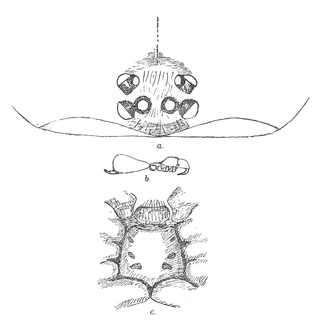
The noble chafer is a species of beetles belonging to the family Scarabaeidae, subfamily Cetoniinae.

The Algodones Dunes is a large sand dune field, or erg, located in the southeastern portion of the U.S. state of California, near the border with Arizona and the Mexican state of Baja California. The field is approximately 45 miles (72 km) long by 6 miles (9.7 km) wide and extends along a northwest-southeast line that correlates to the prevailing northerly and westerly wind directions. The name "Algodones Dunes" refers to the entire geographic feature, while the administrative designation for that portion managed by the Bureau of Land Management is the Imperial Sand Dunes Recreation Area. In 1966, Imperial Sand Hills was designated as a National Natural Landmark by the National Park Service. The Algodones Dunes are split into many different sections. These sections include Glamis, Gordon's Well, Buttercup, Midway, and Patton's Valley. Although the Arabic-derived Spanish word algodones translates to "cotton plants", the origin of the toponym is unknown.

Scarabaeus sacer, common name sacred scarab, is the type species of the genus Scarabaeus and the family Scarabaeidae. This dung beetle is native of southern Europe, northern Africa and western Asia, and it was venerated in ancient Egypt.

The Cromwell chafer beetle is a species of flightless beetle in the family Scarabaeidae. It is found in just one spot in Central Otago, New Zealand, which is now a nature reserve. The population of the “Cromwell chafer beetle” is 13 as of 2023.

Harpegnathos venator is a species of ant found in South and Southeast Asia in northern India and parts of Burma. Like other ants in the genus Harpegnathos, it jumps to capture prey and lives in relatively small nesting colonies.

Xylotrupes gideon, the brown rhinoceros beetle, is a species of large scarab beetle belonging to the subfamily Dynastinae.

Pericoptus is a genus of large scarab beetles found in New Zealand. As many as five species are recognized.

Pericoptus punctatus is a sand scarab beetle that is endemic to New Zealand. It is a smaller and similar New Zealand scarab beetle species to Pericoptus truncatus.
Meloe angusticollis, commonly known as the short-winged blister beetle or oil beetle, is a species of blister beetle, native to North America. They average 9-19 mm in length — females are much larger than males. When disturbed the adult releases oily droplets of hemolymph from its body to repel potential predators, which may cause blistering on human skin.

Cantuaria dendyi is a species of trapdoor spider in the family Idiopidae. It can be found in the South Island of New Zealand and is limited to the Christchurch and Banks Peninsula area.

Pison spinolae, commonly known as mason wasp, is a solitary wasp of the family Crabronidae, native to Australia and found throughout New Zealand where it is an introduced species.

Bodiloides ictericus is a species of dung beetle in the family Scarabaeidae, found in the Palearctic. It is one of more than 50 species in the genus Bodiloides.

Habroscelimorpha dorsalis, commonly known as the eastern beach tiger beetle, is a species of flashy tiger beetle in the family Cicindelidae. It is found in Central America and North America.
Mimela macleayana, is a species of true dung beetle found in India and Sri Lanka.

Scarabaeus gangeticus, is a species of dung beetle found in many Indo-African countries including; India, Sri Lanka, Pakistan, Iran, Saudi Arabia, Egypt, Botswana, Ethiopia, Somalia, Uganda and Zimbabwe.
Zonitoschema krombeini, is a species of blister beetle endemic to Sri Lanka.
Hybosorus orientalis, is a species of scavenger scarab beetle found in Nepal, Pakistan, India, Sri Lanka, Afghanistan, Myanmar, Sumatra, and Java.
Eutassa fuscicollis is a beetle in the Curculionidae family. It was first described by Thomas Broun in 1909, and is endemic to New Zealand

Stethaspis is a genus of beetles in the family Scarabaeidae, subfamily Melolonthinae.

Prodontria longitarsis is a species of flightless beetle in the family Scarabaeidae. This species was first described by Broun in 1909 as Odontria longitarsis. The holotype specimen was collected by George Hudson during the Sub-Antarctic Islands Scientific Expedition and is held at Te Papa.



















